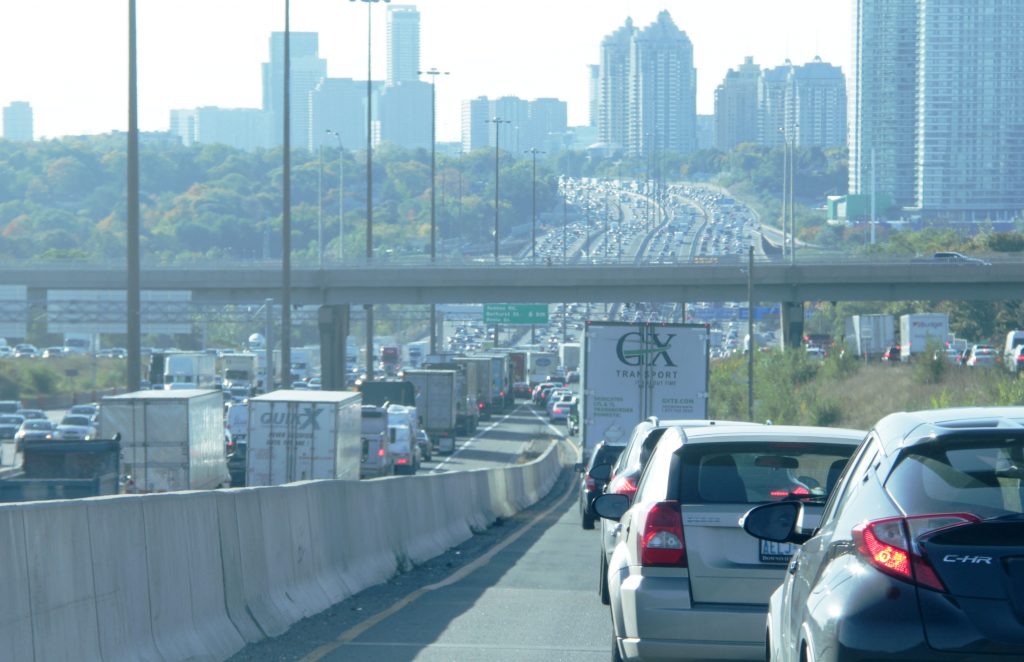

Columns/Blogs
Offbeat Workplace News
Business Travel
Traffic is better, and worse, than before the pandemic
October 3, 2022
By
Todd Humber
 The opportunity to work remotely during the pandemic has many considering escaping commutes such as Toronto's 401 highway. (Talent Canada)
The opportunity to work remotely during the pandemic has many considering escaping commutes such as Toronto's 401 highway. (Talent Canada) “Your commute to work this morning is 55 minutes in heavy traffic.”
That’s how my Google Nest greeted me this morning as I poured coffee beans into the burr grinder. The device has a daily habit of telling me exactly how long the drive is from my home to the offices of Annex Business Media in Toronto, publishers of Talent Canada.
Well, habit isn’t quite right. More of a programming reality, since I told the device to do that — it eliminates gridlock shock and dictates how long I can spend drinking that coffee.
If someone decides to roll their car over on Highway 404 and block two lanes, I can adjust accordingly.
Just a couple of months ago, as I fumbled with the coffee beans, Google would regularly tell me my commute time was “34 minutes in light traffic.”
That’s a 61.8 per cent increase in commuting time. Or, put another way and to quote U.S. president Joe Biden, the “pandemic is over.” Not so much the disease part, which stubbornly exists. But our appetite for lockdowns and browsing Netflix 24/7 has come to an end.
We’re back on the highways, buses, trains and subways en masse. But wasn’t the promise of hybrid work, remote work and all those city dwellers who fled to far-flung rural counties with strong Internet supposed to end the gridlock?
Wishful thinking. There remain, of course, plenty of jobs that can never be done remotely in all types of critical industries — those workers never got off the roads.
Perhaps a dent?
Though, it appears there is at least a palpable dent in the commute as a result of the pandemic. Because, in February of 2019, my Google device used to regularly let me know that my commute was “one hour and five minutes in heavy traffic.”
While this data is not peer-reviewed, and I’m not driving it on the daily anymore, I can conclusively say this much:
For me, the world of remote and hybrid work has decreased the average drive time by 15 per cent. That is significant for the Greater Toronto Area, where traffic has only ever gotten worse every single day since the automobile was invented.
The crawl continues
Don’t get me wrong: Traffic in Toronto remains foul. I was reminded of this on Saturday as I sat behind the wheel of a UHaul navigating the Gardiner, 427, 401 and 400. (If you drive in the 416, sorry for that shudder that shot down your spine as I recited those roadways.)
All I was trying to do was pilot the beast 60 kilometres from my stepdaughter’s new downtown condo to its resting place in a bucolic suburban concrete lot. (If your name is Cali, you’re welcome. Please don’t move again for a while.)
The drive should have taken an hour. It took two, with my foot spending most of its time on the brake pedal — and that was hours before the Blue Jays game got out.
Some real data
Lex Harvey, the Toronto Star’s transportation reporter, spent a day last week purposely getting stuck in traffic. While we can question her sanity, her reporting did uncover one truth: Traffic is down, but the average trip is taking just as long.
“During the week of Sept. 12, the average trip in Toronto during morning rush hour (8 to 9 a.m.) took 61 per cent longer than it would have taken during “free-flow” conditions,” she wrote. “In other words, if a trip would have taken 30 minutes without traffic, it instead took about 48 minutes. That’s the same as the average for the year before the pandemic.”
Harvey’s statistics used City of Toronto traffic data. Which might carry more… gravitas.. than the Google device in my kitchen. (But it also shows me recipes. Let’s see you do that, traffic data.)
Here’s what we can say without hesitation: Traffic is bad, occasionally better and often worse.
We’re complaining about it again, which means at least one thing has returned 100 per cent to normal. But why’d it have to be traffic?
Print this page